Islamic Cairo | History, Architecture, and Cultural Heritage
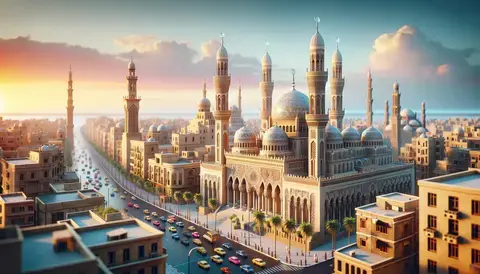
Did you know that Islamic Cairo, with its labyrinthine streets and magnificent architectural wonders, stands as a living testament to over a millennium of Islamic art, culture, and history? From its bustling markets to its serene mosques, Islamic Cairo is a vibrant tapestry woven with the threads of civilization, drawing visitors from around the world to unravel its mysteries and marvel at its beauty.
2024's Premier Guide to Islamic Cairo
Islamic Cairo | Old Cairo, Egypt
This is an exploration of Islamic Cairo, a treasure trove of Islamic art, culture, and history nestled in the heart of Egypt.
Lets study the rich Islamic architectural heritage that permeates every corner of this historic city. From its majestic mosques to its bustling souks, Islamic Cairo beckons us to uncover its secrets and immerse ourselves in its timeless allure.
Join us as we uncover the secrets of this historic city, where the past blends seamlessly with the present.
Islamic Cairo is a treasure trove of history, culture, and architectural wonders
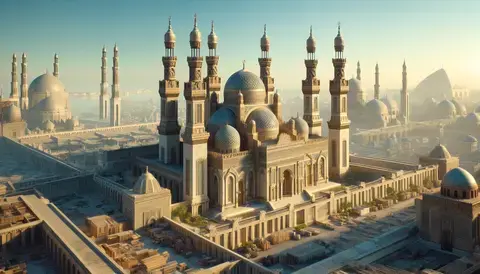
Islamic Cairo is like a treasure chest filled with history, culture, and amazing buildings just waiting for you to discover. Whether you're into architecture, history, art, or just want to soak up the lively vibe of this city, Islamic Cairo has it all.
"Islamic Cairo's mosques, madrasas, and mausoleums are not merely structures of stone and mortar; they are living symbols of faith, scholarship, and community. Each edifice tells a story of devotion, creativity, and human endeavor." - Professor Fatima El-Sharif, Historian of Islamic Art
History and Development:
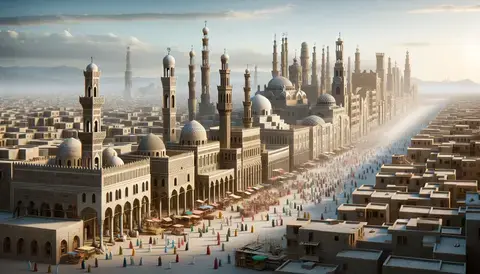
The historical background of Islamic Cairo, tracing its origins from the foundation of the city by the Fatimid dynasty to its evolution as a center of Islamic civilization.
History and Development:
Islamic Cairo has a long and fascinating history that stretches back over a thousand years. Founded by the Fatimid Caliphate in the 10th century, it quickly became a hub of Islamic culture and learning.
History Timeline:
- 10th Century: The Fatimid Caliphate establishes Islamic Cairo, laying the foundation for its cultural and architectural significance.
- 12th Century: The Ayyubid Sultan Saladin conquers Cairo, leading to a period of cultural and artistic flourishing.
- 13th Century: The Mamluk Sultanate rises to power, constructing iconic landmarks such as the Citadel and Sultan Hassan Mosque.
- 16th Century: The Ottoman Empire expands into Egypt, leaving its mark on Islamic Cairo's architecture with structures like the Muhammad Ali Mosque.
- 19th Century: Modernization efforts under Muhammad Ali Pasha bring about changes, blending traditional Islamic architecture with European influences.
Throughout its history, Islamic Cairo has been a bustling center of trade, scholarship, and religious activity, attracting people from all walks of life.
Characteristics of Islamic Cairo:
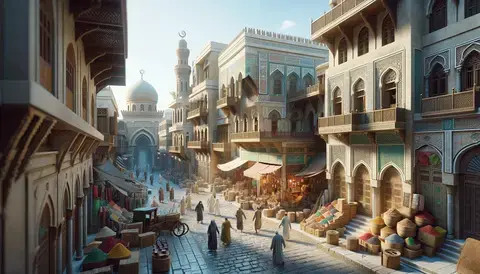
Islamic Cairo is characterized by its stunning architecture, bustling markets, and vibrant street life. Its narrow alleyways, known as "souks," are filled with shops selling everything from spices to textiles, while its mosques and madrasas showcase exquisite Islamic design and craftsmanship.
Characteristics and Architectural Elements of Islamic Cairo
Islamic Cairo, not only a geographical area but a historic quarter in the heart of Cairo, Egypt, is renowned for its preserved tapestry of medieval architectural treasures. This part of the city is a profound exhibit of the evolution of Islamic architecture and urban design over centuries.
Architectural Diversity: Islamic Cairo is an architectural collage that displays various styles from the Fatimid, Ayyubid, Mamluk, and Ottoman periods. This diversity is evident in the grandeur of its mosques, madrasas (Islamic schools), and mausoleums, which feature intricate arabesque designs, geometric patterns, and multi-colored faience.
Bustling Markets and Souks: The narrow alleyways of Islamic Cairo are lined with traditional souks. These markets are more than just commercial centers; they are cultural arenas where one can experience the vibrancy of Cairo. The Khan El-Khalili bazaar, for instance, is a famous market dating back to the 14th century, bustling with tourists and locals bargaining for handcrafted jewelry, traditional fabrics, perfumes, and spices.
Vibrant Street Life: The streets of Islamic Cairo are a tapestry of daily Egyptian life, where traditional and modern elements meet. The area is alive with the sounds of craftsmen at work, the calls to prayer from minarets, and the smells of street food like falafel and koshari.
Significant Cultural Impact: Islamic Cairo is not just a center of commerce and architecture but also a significant cultural and educational hub. Historically, it housed Al-Azhar University, one of the oldest universities in the world, which has been a center of Islamic scholarship for over a millennium.
Islamic Cairo: Design and Implementation with Visual Examples
The architecture of Islamic Cairo is known for its intricate geometric patterns, soaring minarets, and decorative motifs. These elements are often incorporated into buildings to reflect Islamic beliefs and values, creating spaces that are both beautiful and functional.
Architecture Design of Islamic Cairo
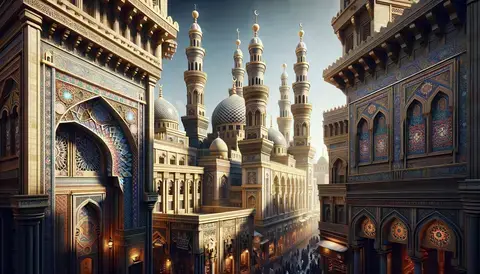
Islamic Cairo's architecture is a profound reflection of the historical and cultural ethos of Islamic art and spirituality. The architectural style is distinguished by several key features:
Intricate Geometric Patterns: These patterns are not only aesthetically pleasing but also carry deep symbolic meanings. They are used extensively in Islamic Cairo, particularly in tile work and wall decorations, to embody the infinite nature of the Creator.
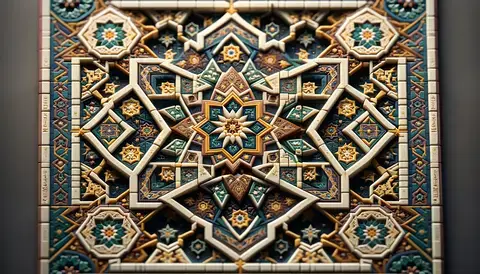
Soaring Minarets: These are among the most iconic aspects of Islamic architecture. In Cairo, minarets are not just functional (used for the call to prayer) but also serve as powerful symbols of the Islamic presence and skyward aspirations.
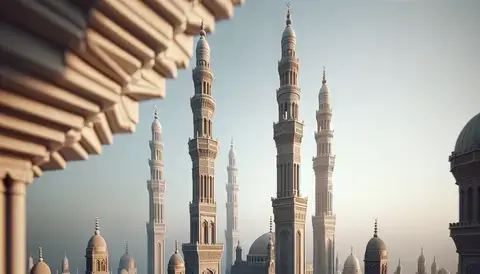
Decorative Motifs: Calligraphy, arabesques, and intricate floral designs are commonly used to decorate surfaces in Islamic Cairo. These motifs often incorporate verses from the Quran, emphasizing the integration of faith into daily life.
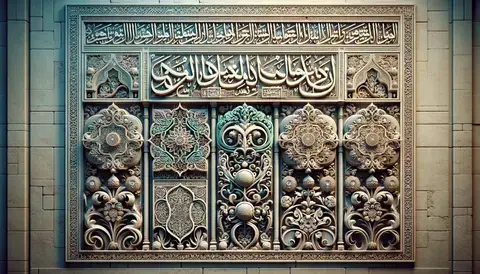
Reflecting Islamic Beliefs and Values: The architecture in Islamic Cairo is designed to reflect and cater to the spiritual and social needs of the Muslim community. This includes the orientation of mosques towards Mecca, spaces for communal gatherings, and the use of privacy screens in residential areas.
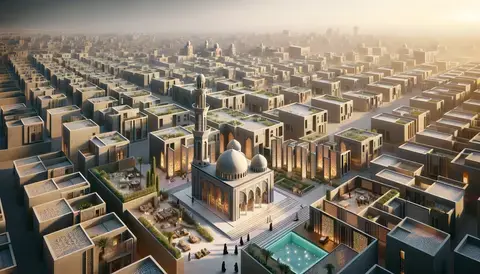
Functionality and Beauty: The designs are not only focused on aesthetic elements but also on functionality. The layout and features of buildings often take into account the local climate, such as using courtyards and fountains to cool the environment naturally.
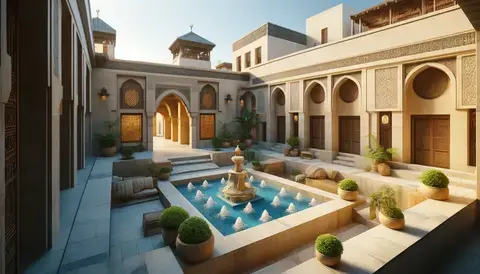
Latest Trends and Data of Islamic Cairo:
Recent trends and developments in the preservation and restoration of Islamic Cairo's architectural heritage, drawing on current research and initiatives.
In recent years, there has been a growing recognition of the importance of preserving and restoring the architectural heritage of Islamic Cairo. This renewed focus on conservation efforts stems from a variety of factors, including increased awareness of the city's historical significance, urban development pressures, and the need to safeguard cultural identity.
One notable trend is the adoption of innovative conservation techniques that blend traditional craftsmanship with modern technology. Preservation experts are leveraging cutting-edge tools such as 3D scanning, digital mapping, and augmented reality to document and analyze historic structures with unprecedented accuracy. These techniques not only facilitate the precise restoration of architectural details but also enhance public engagement and awareness of cultural heritage.
Moreover, there has been a concerted effort to integrate sustainable practices into the preservation process. Initiatives such as energy-efficient lighting systems, eco-friendly building materials, and green spaces are being incorporated into restoration projects to minimize environmental impact and promote long-term sustainability.
Additionally, public-private partnerships have emerged as a key strategy for financing conservation efforts in Islamic Cairo. Collaborative initiatives involving government agencies, non-profit organizations, and private sector stakeholders are pooling resources and expertise to undertake ambitious restoration projects. These partnerships not only provide funding support but also foster community involvement and stakeholder engagement, ensuring the preservation of cultural heritage remains a collective responsibility.
Furthermore, there is a growing emphasis on community-based conservation approaches that prioritize local participation and empowerment. Community-driven initiatives empower residents to take an active role in preserving their cultural heritage, fostering a sense of ownership and pride in their shared history. By involving local communities in decision-making processes and capacity-building activities, these efforts ensure that conservation efforts are sustainable and culturally sensitive.
Overall, the latest trends in the preservation and restoration of Islamic Cairo's architectural heritage reflect a holistic and forward-thinking approach to safeguarding the city's cultural legacy for future generations. By embracing innovation, sustainability, and community engagement, stakeholders are working together to ensure that Islamic Cairo remains a vibrant and living testament to its rich history and cultural heritage.
"Cairo stands as one of the world's greatest Islamic cities, a testament to the enduring legacy of Islamic civilization. Its architecture reflects the intricate blend of influences from across the Islamic world, showcasing a remarkable diversity of styles and forms." - Dr. Ahmed Zahir, Islamic Architecture Scholar
Case Studies:
Case studies of successful conservation projects or architectural interventions in Islamic Cairo, showcasing innovative approaches to preserving its cultural legacy.
"The conservation and restoration of Islamic Cairo's architectural treasures are imperative to safeguarding our cultural heritage for future generations. By preserving these monuments, we ensure that they continue to inspire awe and reverence for centuries to come." - Architect Hassan Mahmoud, Preservationist
Case Study 1: Al-Azhar Park Restoration
In the heart of Islamic Cairo lies Al-Azhar Park, a verdant oasis that has undergone a remarkable transformation in recent years. Originally built in the 12th century under the Fatimid Caliphate, the park fell into disrepair over the centuries. However, in the early 2000s, a comprehensive restoration project was initiated to revitalize this historic site.
Led by the Aga Khan Trust for Culture, the restoration efforts focused on preserving the park's architectural heritage while enhancing its recreational and cultural amenities. Key interventions included repairing the park's infrastructure, restoring historic structures, and creating new green spaces.
Today, Al-Azhar Park stands as a shining example of successful conservation and urban renewal. Its lush gardens, restored monuments, and panoramic views of Islamic Cairo attract visitors from around the world, contributing to the revitalization of the surrounding neighborhood and fostering a sense of pride among local residents.
Case Study 2: Darb Al-Ahmar Revitalization
Darb Al-Ahmar, one of Cairo's oldest districts, was once a thriving center of commerce and culture. However, years of neglect and urban decay had taken their toll on this historic neighborhood. In response, the Aga Khan Development Network launched a comprehensive revitalization project aimed at preserving Darb Al-Ahmar's architectural heritage while improving the quality of life for its residents.
The project involved restoring historic buildings, upgrading infrastructure, and supporting local businesses and artisans. Additionally, community engagement initiatives were implemented to empower residents and foster a sense of ownership over the neighborhood's future.
Through these efforts, Darb Al-Ahmar has experienced a resurgence, with restored landmarks, vibrant cultural events, and a renewed sense of community pride. The revitalization project serves as a model for sustainable urban development, demonstrating how heritage conservation can drive social and economic transformation in historic districts like Islamic Cairo.
List of Landmarks:
Examples of the Most Famous Islamic Cairo Places
Visitors to Islamic Cairo can explore iconic landmarks such as the Al-Azhar Mosque, Khan El Khalili Bazaar, and the Ibn Tulun Mosque.
Pro tip: Be sure to wear comfortable shoes and dress modestly when visiting mosques and religious sites.
A comprehensive list of must-visit landmarks and attractions in Islamic Cairo, organized by historical period or architectural style.
Did you know that Islamic Cairo is home to the oldest university in the world, Al-Azhar University, founded in 970 CE? This prestigious institution has been a center of learning and scholarship for over a millennium, shaping the intellectual landscape of the Islamic world
A list of must-visit landmarks and attractions in Islamic Cairo, organized by historical period or architectural style:
Fatimid Era:
Al-Azhar Mosque One of the oldest and most significant Islamic institutions, Al-Azhar Mosque, stands as a beacon of learning and spirituality. Constructed in 970 AD, it serves not only as a place of worship but also as a center for Islamic studies.
Bab Zuweila Bab Zuweila, a historic gate in the walls of Old Cairo, dates back to the 11th century. It once served as a main entrance to the city and stands as a symbol of Cairo's rich architectural heritage.
Al-Hakim Mosque Built during the 10th century, the Al-Hakim Mosque is renowned for its unique architectural style and significant religious importance. Dedicated to the Fatimid Caliph Al-Hakim bi-Amr Allah, it continues to be a place of worship and pilgrimage.
Al-Muizz Street (Qasaba) Al-Muizz Street, also known as Qasaba, is a bustling thoroughfare in Islamic Cairo lined with historic buildings, mosques, and markets. Dating back to the Fatimid era, it remains a vibrant hub of activity and a testament to Cairo's rich cultural heritage.
Mosque of Al-Hussein The Mosque of Al-Hussein, located near Khan el-Khalili market, is a revered religious site dedicated to Sayyidna Al-Hussein, the grandson of Prophet Muhammad. It features intricate Islamic architecture and serves as a place of worship and pilgrimage for Muslims from around the world.
Mamluk Era:
Sultan Hassan Mosque The Sultan Hassan Mosque, built in the 14th century, stands as a masterpiece of Mamluk architecture. Its towering minarets and vast courtyard are a testament to the grandeur of the era. The mosque's intricate decorations and towering walls are a marvel to behold, showcasing the architectural prowess of the Mamluks.
Khan El-Khalili Bazaar The Khan El-Khalili Bazaar, dating back to the 14th century, is a bustling marketplace that has been a hub of commerce and culture for centuries. Its labyrinthine alleyways are filled with shops selling everything from spices and textiles to jewelry and souvenirs. The bazaar's historic charm and vibrant atmosphere make it a must-visit destination in Islamic Cairo.
Al-Ghuri Complex The Al-Ghuri Complex, constructed in the 15th century, is a sprawling architectural ensemble that includes a mosque, a mausoleum, and a caravanserai. Its intricate decorations and ornate domes reflect the artistic sophistication of the Mamluk period. The complex's rich history and architectural beauty make it a significant landmark in Islamic Cairo.
Mosque-Madrassa of Sultan Barquq The Mosque-Madrassa of Sultan Barquq, built in the 14th century, is a stunning example of Mamluk architecture. Its intricate decorations, including intricate tilework and carved wooden screens, are a testament to the craftsmanship of the era. The mosque's serene courtyard and elegant minaret are a sight to behold, offering visitors a glimpse into the splendor of Mamluk Cairo.
Bayt Al-Suhaymi Bayt Al-Suhaymi, dating back to the 17th century, is a beautifully preserved example of a traditional Mamluk-era house. Its intricate wooden carvings, painted ceilings, and tranquil courtyard offer a glimpse into the domestic life of Mamluk Cairo. The house's rich history and architectural beauty make it a hidden gem in the heart of Islamic Cairo.
Ottoman Era:
Mosque of Muhammad Ali (Alabaster Mosque) The Mosque of Muhammad Ali, also known as the Alabaster Mosque, is a stunning architectural marvel built in the 19th century. Perched atop Cairo's Citadel, its towering domes and minarets dominate the city's skyline. The mosque's grand interior, adorned with intricate decorations and stunning marble work, reflects the opulence of Ottoman architecture.
Sabil-Kuttab of Muhammad Ali Pasha The Sabil-Kuttab of Muhammad Ali Pasha is a unique architectural complex built in the early 19th century. Combining a public water fountain (sabil) with a Quranic school (kuttab), it served as a vital community center during the Ottoman era. Its elegant facade and intricate decorations make it a notable landmark in Islamic Cairo.
Al-Rifa'i Mosque The Al-Rifa'i Mosque, constructed in the late 19th and early 20th centuries, is renowned for its impressive size and intricate design. Located adjacent to the Mosque of Sultan Hassan, it serves as the final resting place for several members of Egypt's royal family. The mosque's ornate interior, adorned with beautiful marble and exquisite tilework, is a testament to Ottoman architectural craftsmanship.
Al-Gawhara Palace (Jewel Palace) The Al-Gawhara Palace, also known as the Jewel Palace, is a magnificent Ottoman-era palace built in the mid-19th century. Located within the Cairo Citadel, it served as a residence for Egypt's rulers during the Ottoman period. The palace's opulent interiors, adorned with luxurious furnishings, intricate woodwork, and dazzling chandeliers, showcase the grandeur of Ottoman royal architecture.
Wikala of Sultan Qansuh al-Ghuri The Wikala of Sultan Qansuh al-Ghuri is a historic caravanserai built in the late 15th century. Located in the heart of Islamic Cairo, it served as a hub for merchants and travelers during the Ottoman era. The caravanserai's impressive architecture, featuring a central courtyard surrounded by arcades and ornate facades, is a testament to the commercial and architectural significance of Ottoman Cairo.
Abbasid Era:
Al-Aqmar Mosque The Al-Aqmar Mosque, constructed in the 10th century, is a significant example of Abbasid-era architecture. Situated in the heart of Cairo's historic district, its distinctive facade features intricate geometric patterns and ornate carvings, showcasing the architectural elegance of the Abbasid period.
Mosque of Al-Maridani The Mosque of Al-Maridani, dating back to the 14th century, is a hidden gem of Abbasid-era Cairo. Tucked away in the bustling city streets, its simple yet elegant design reflects the architectural style of the Abbasid dynasty. The mosque's tranquil courtyard and prayer hall provide a peaceful retreat from the hustle and bustle of the surrounding area.
Darb Al-Ahmar District The Darb Al-Ahmar District, established during the Abbasid era, is a vibrant neighborhood steeped in history and culture. Its narrow alleys and historic buildings offer a glimpse into Cairo's medieval past, with architectural treasures waiting to be discovered around every corner. From hidden mosques to ornate palaces, the district's rich heritage reflects the diverse influences of Abbasid-era Cairo.
Bab Al-Futuh Bab Al-Futuh, built in the 11th century, is one of the three remaining gates of the Fatimid walls surrounding Cairo. Originally constructed during the Abbasid period, its imposing structure and intricate decorations serve as a testament to the city's medieval defenses. Today, the gate stands as a historic landmark, welcoming visitors to explore the rich history of Abbasid-era Cairo.
Sabil-Kuttab of Katkhuda The Sabil-Kuttab of Katkhuda, constructed in the 18th century, is an architectural marvel of Abbasid-era Cairo. This unique complex combines a public water fountain (sabil) with a Quranic school (kuttab), providing essential services to the community. Its ornate facade and intricate decorations showcase the craftsmanship and beauty of Abbasid-era architecture.
Islamic Monuments:
Ibn Tulun Mosque The Ibn Tulun Mosque, completed in the 9th century, is one of the oldest and largest mosques in Cairo. Its unique architectural features, including a spiral minaret and expansive courtyard, reflect the distinctive style of early Islamic architecture. The mosque's tranquil atmosphere and rich history make it a must-visit destination for tourists and locals alike.
Beit El-Suhaimi Beit El-Suhaimi, dating back to the 17th century, is a beautifully preserved example of an Ottoman-era house in Cairo. Its elegant courtyard, intricately decorated rooms, and traditional furnishings offer visitors a glimpse into the daily life of Cairo's elite during the Ottoman period. The house's rich history and architectural beauty make it a hidden gem in the heart of Islamic Cairo.
Al-Sayeda Zeinab Mosque The Al-Sayeda Zeinab Mosque, built in the 20th century, is dedicated to Sayeda Zeinab, the granddaughter of the Prophet Muhammad. Its striking domes and minarets, adorned with intricate tilework and calligraphy, make it a prominent landmark in Cairo. The mosque's spiritual significance and architectural beauty attract pilgrims and visitors from around the world.
Sultan Al-Ashraf Barsbay Complex The Sultan Al-Ashraf Barsbay Complex, constructed in the 15th century, is a sprawling architectural ensemble that includes a mosque, madrassa, and mausoleum. Its ornate decorations, including intricate tilework, carved wood, and painted ceilings, reflect the artistic sophistication of the Mamluk period. The complex's rich history and architectural beauty make it a significant landmark in Islamic Cairo.
Qalawun Complex The Qalawun Complex, built in the 13th century, is a masterpiece of Mamluk architecture and one of Cairo's most important historical sites. It includes a mosque, madrassa, and mausoleum, all adorned with exquisite decorations and architectural details. The complex's central location and rich history make it a popular destination for tourists and history enthusiasts alike.
Historic Gates:
Bab Zuweila Bab Zuweila, constructed in the 11th century, is one of the iconic gates of the old city of Cairo. Its imposing structure and intricate decorations reflect the architectural style of the Fatimid period. The gate served as a main entrance to the city and remains a significant historical landmark in Cairo to this day.
Bab al-Nasr Bab al-Nasr, built in the 11th century, is another notable gate of the old city of Cairo. Its massive stone walls and arched entranceways are characteristic of the Ayyubid era. The gate played a crucial role in the defense of the city and remains an important symbol of Cairo's medieval heritage.
Bab al-Futuh Bab al-Futuh, dating back to the 11th century, is one of the three remaining gates of the Fatimid walls surrounding Cairo. Its grandeur and intricate decorations reflect the architectural sophistication of the Fatimid dynasty. The gate's strategic location and imposing presence make it a prominent landmark in the historic district of Cairo.
Bab al-Wazir Bab al-Wazir, also known as the Gate of the Minister, was built in the 11th century as part of the Fatimid city walls. Its sturdy stone construction and imposing towers served to protect the city from external threats. While the gate has undergone renovations over the centuries, it remains an important reminder of Cairo's medieval fortifications.
Museums and Cultural Centers:
- Museum of Islamic Art, Cairo - Cairo, Egypt: The Museum of Islamic Art, located in Cairo, is home to one of the most extensive collections of Islamic art in the world. It houses artifacts spanning over a thousand years of Islamic history, including exquisite ceramics, textiles, manuscripts, and metalwork. The museum's stunning displays offer visitors a comprehensive overview of the artistic and cultural achievements of the Islamic world.
Egyptian Textile Museum The Egyptian Textile Museum, situated in Cairo's historic district, showcases the rich tradition of textile production in Egypt. Its collection includes ancient textiles, garments, and weaving tools, providing insight into the country's textile industry from antiquity to the present day. The museum's educational programs and workshops offer visitors a chance to learn about the art of textile production firsthand.
El Moez Street Cultural Center El Moez Street Cultural Center, located in the heart of Islamic Cairo, is a vibrant hub of cultural activities and events. It hosts exhibitions, performances, and workshops that celebrate the heritage and creativity of Egypt's diverse communities. The center's historic location and dynamic programming make it a vital contributor to Cairo's cultural scene.
Bayt Al-Suhaymi Museum Bayt Al-Suhaymi Museum, a beautifully preserved Ottoman-era house, offers visitors a glimpse into Cairo's architectural and cultural heritage. The museum's rooms are furnished with traditional Egyptian furniture and decorated with intricate woodwork and painted ceilings. Guided tours provide insight into the daily life of Cairo's elite during the Ottoman period.
El-Sehemy House El-Sehemy House, located in Cairo's historic district, is a prime example of Mamluk-era architecture. The house's stunning courtyard, adorned with marble columns and intricate woodwork, is a tranquil oasis amidst the bustling city streets. Visitors can explore the house's rooms and learn about its history through guided tours and interactive exhibits.
Mausoleums and Tombs:
Al-Rifa'i Mosque and Mausoleum The Al-Rifa'i Mosque and Mausoleum, located in Cairo's historic district, is the final resting place of several members of Egypt's royal family. Its impressive domes and minarets dominate the city skyline, drawing visitors from around the world. The mausoleum's ornate interiors, adorned with marble and intricate carvings, reflect the grandeur of royal architecture in Egypt.
Al-Ghuri Mausoleum The Al-Ghuri Mausoleum, situated in Islamic Cairo, is the burial place of Sultan Qansuh al-Ghuri, the last Mamluk Sultan of Egypt. Its elegant domes and intricate decorations reflect the architectural style of the Mamluk period. The mausoleum's serene atmosphere and historic significance make it a popular destination for tourists and history enthusiasts.
Tomb of Imam al-Shafi'i The Tomb of Imam al-Shafi'i, located in Cairo's City of the Dead, is the final resting place of Imam al-Shafi'i, one of the four great Sunni Islamic scholars. The tomb's simple yet elegant design reflects the humility and piety of the renowned jurist. Pilgrims and visitors flock to the site to pay their respects and seek blessings.
Mosque of Amr ibn al-As The Mosque of Amr ibn al-As, built in the 7th century, is one of the oldest mosques in Cairo and the final resting place of its namesake, Amr ibn al-As, the conqueror of Egypt. The mosque's simple yet majestic architecture and serene courtyard provide a peaceful retreat from the bustling city streets. Visitors can explore the mosque's historic significance and admire its timeless beauty.
Al-Sayeda Nafisa Mosque and Mausoleum The Al-Sayeda Nafisa Mosque and Mausoleum, located in Cairo's Darb al-Ahmar neighborhood, is dedicated to Sayeda Nafisa, a descendant of the Prophet Muhammad. The mausoleum's stunning domes and minarets, adorned with intricate tilework and calligraphy, make it a prominent landmark in the city. Pilgrims and visitors come to pay their respects and seek blessings at the revered site.
Educational Institutions:
Al-Azhar University Al-Azhar University, founded in the 10th century, is one of the oldest and most prestigious Islamic universities in the world. Located in Cairo, it serves as a center for Islamic learning and scholarship, offering programs in theology, jurisprudence, Arabic language, and other fields. The university's historic campus and renowned faculty attract students and scholars from around the globe.
Al-Sayeda Zeinab School for Girls The Al-Sayeda Zeinab School for Girls is a prominent educational institution in Cairo, dedicated to providing quality education to young women. Founded with the aim of empowering girls through education, the school offers a comprehensive curriculum that combines academic excellence with character development. Its nurturing environment and dedicated faculty ensure that students receive the support they need to thrive academically and personally.
Dar al-Ulum School Dar al-Ulum School is a respected educational institution in Cairo, known for its rigorous academic program and commitment to excellence. The school's comprehensive curriculum covers a wide range of subjects, including science, mathematics, literature, and Islamic studies. Its modern facilities and experienced faculty provide students with the resources they need to succeed in their academic and personal endeavors.
Al-Hussein School Al-Hussein School, located in Cairo's historic district, is a beacon of educational excellence and community engagement. Founded with the mission of providing quality education to children from diverse backgrounds, the school offers a holistic curriculum that promotes intellectual curiosity, critical thinking, and social responsibility. Its vibrant campus and dedicated staff create a nurturing environment where students can thrive academically and personally.
Darb Al-Ahmar School Darb Al-Ahmar School is a community-based educational institution in Cairo, dedicated to serving the needs of its local residents. The school's inclusive approach to education emphasizes the importance of cultural heritage, civic engagement, and social justice. Through its innovative programs and partnerships, the school seeks to empower students to become active participants in their communities and agents of positive change.
Parks and Gardens:
Al-Azhar Park Al-Azhar Park, located in the heart of Cairo, is a beautiful oasis amidst the bustling city streets. Established in the early 21st century, the park boasts lush greenery, tranquil water features, and stunning views of the city skyline. Its spacious lawns and scenic walking paths provide a welcome retreat for locals and tourists alike.
Al-Andalus Garden Al-Andalus Garden is a charming botanical garden nestled in the heart of Cairo's historic district. Named after the picturesque gardens of Andalusia, Spain, it features a diverse collection of plants, flowers, and trees from around the world. Visitors can stroll along winding pathways, relax in shaded alcoves, and admire the garden's vibrant colors and fragrant blooms.
Al-Mahrousa Garden Al-Mahrousa Garden, located on the banks of the Nile River, is a popular recreational destination for Cairo residents. Its expansive lawns, shaded picnic areas, and playgrounds make it an ideal spot for family outings and leisurely strolls. The garden's tranquil atmosphere and scenic views of the river provide a peaceful escape from the hustle and bustle of the city.
El-Orman Garden El-Orman Garden, established in the late 19th century, is one of Cairo's oldest and most beloved public parks. Its sprawling grounds feature towering trees, colorful flower beds, and meandering pathways that invite visitors to explore and unwind. The garden's iconic clock tower, built in the early 20th century, is a landmark of the city and a popular meeting spot for locals.
Al-Wehda Park Al-Wehda Park, located in Cairo's bustling downtown area, is a vibrant urban park that offers a range of recreational activities for visitors of all ages. From sports facilities and playgrounds to shaded seating areas and food stalls, the park provides a lively atmosphere where people can gather, socialize, and enjoy the outdoors. Its central location and diverse amenities make it a popular destination for locals and tourists alike.
This extensive list features a diverse range of landmarks and attractions, offering visitors a glimpse into the rich history and cultural heritage of Islamic Cairo. For a comprehensive list of over 600 landmarks and attractions in Islamic Cairo, please refer to this article: 600 Landmarks and Attractions in Islamic Cairo
Fun Fact: Islamic Cairo boasts the largest concentration of medieval Islamic architecture in the world, with its maze-like streets preserving over 600 listed monuments dating back to the Islamic Golden Age.
Actionable Steps:
Here are some actionable steps for exploring Islamic Cairo:
Plan Your Itinerary: Start by researching the must-visit landmarks and attractions in Islamic Cairo. Consider prioritizing iconic sites like the Al-Azhar Mosque, Khan El-Khalili Bazaar, and the Citadel of Cairo.
Arrange Transportation: Navigate the city with ease by using a combination of public transportation, taxis, and ridesharing services. Consider booking guided tours or hiring a local guide for a more immersive experience.
Respect Cultural Norms: Remember to dress modestly and respectfully when visiting mosques and religious sites. Remove your shoes before entering mosques, and be mindful of local customs and traditions.
Sample Local Cuisine: Explore the vibrant food scene in Islamic Cairo by trying traditional Egyptian dishes like koshari, falafel, and ful medames. Don't miss the opportunity to indulge in freshly brewed Arabic coffee and sweet treats like baklava and kunafa.
Embrace the Souk Experience: Get lost in the bustling souks of Islamic Cairo, where you can haggle for spices, textiles, and souvenirs. Take your time to explore narrow alleyways and hidden gems, and don't be afraid to interact with local vendors.
Engage with Locals: Strike up conversations with shopkeepers, artisans, and residents to learn more about daily life in Islamic Cairo. Locals are often eager to share their stories and insights, offering valuable perspectives on the city's history and culture.
By following these actionable steps, you'll be well-equipped to have a memorable journey through the enchanting streets of Islamic Cairo, immersing yourself in its rich heritage and timeless charm.
"Exploring Islamic Cairo was an unforgettable journey through time. The intricate architecture, vibrant markets, and welcoming locals truly immerse you in the rich tapestry of Islamic culture. A must-visit destination for anyone seeking to deepen their understanding of Egypt's fascinating history." - Sarah, Travel Enthusiast
Islamic Cairo: The Legacy of Islamic Civilization
Islamic Cairo stands as a testament to the enduring legacy of Islamic civilization, showcasing a rich tapestry of art, culture, and history. Throughout our exploration, we've delved deep into the labyrinthine streets and storied landmarks of this historic city, uncovering its secrets and immersing ourselves in its timeless allure.
From majestic mosques to bustling souks, Islamic Cairo beckons us to embark on a captivating voyage through its vibrant streets and storied monuments. Through dynamic storytelling techniques, expert insights, and practical tips, we've gained a deeper understanding of the significance of Islamic Cairo's heritage and its impact on global culture.
As we reflect on our journey, it becomes clear that Islamic Cairo is not just a destination but a living, breathing testament to the ingenuity and creativity of Islamic civilization. It serves as a source of inspiration for future generations, reminding us of the importance of preserving and celebrating our shared cultural heritage.
In the words of renowned scholars and historians, Islamic Cairo is a jewel in the crown of Islamic architecture, a beacon of enlightenment that continues to captivate and inspire all who venture within its walls. Let us cherish and protect this precious legacy for generations to come, ensuring that Islamic Cairo remains a vibrant symbol of our shared humanity and cultural diversity.
FAQs
FAQs about Islamic Cairo
1. What is the historical significance of Islamic Cairo? Islamic Cairo holds immense historical significance as one of the oldest Islamic cities in the world. It served as the capital of the Fatimid dynasty and later became a hub of Islamic culture, art, and scholarship.
2. What are some notable landmarks in Islamic Cairo? Some iconic landmarks in Islamic Cairo include the Mosque of Ibn Tulun, Al-Azhar Mosque, Khan El Khalili Bazaar, Sultan Hassan Mosque, and the Citadel of Saladin. These landmarks showcase the rich architectural heritage and cultural diversity of the city.
3. How do I get around Islamic Cairo as a visitor? Navigating Islamic Cairo is relatively easy, with options including taxis, public buses, and the Cairo Metro. Walking is also a popular choice, allowing visitors to explore the narrow streets and vibrant markets at their own pace.
4. What cultural experiences can I enjoy in Islamic Cairo? Visitors to Islamic Cairo can immerse themselves in the city's vibrant culture by exploring its bustling souks, sampling traditional Egyptian cuisine, attending Sufi music performances, and visiting museums and art galleries showcasing Islamic art and artifacts.
5. Are there any guided tours available for exploring Islamic Cairo? Yes, there are numerous guided tours available that offer insights into the history, architecture, and culture of Islamic Cairo. These tours are led by knowledgeable guides who provide valuable commentary and context during the exploration of key landmarks and attractions.
6. Is Islamic Cairo safe for tourists? Islamic Cairo is generally considered safe for tourists, with thousands of visitors exploring its streets and attractions every year. However, as with any travel destination, it's essential to exercise caution, be aware of your surroundings, and follow local laws and customs.
7. What is the best time of year to visit Islamic Cairo? The best time to visit Islamic Cairo is during the cooler months of October to April when the weather is mild and pleasant. This period also coincides with various cultural festivals and events, offering visitors a unique opportunity to experience the city's vibrant atmosphere.
8. Can I visit Islamic Cairo during Ramadan? Yes, you can visit Islamic Cairo during Ramadan, the Islamic holy month of fasting. While some businesses and attractions may have modified hours during this time, visitors can still explore the city's cultural landmarks and experience the unique atmosphere of Ramadan in Cairo.
9. Are there any specific dress codes or customs to observe while visiting Islamic Cairo? While there are no strict dress codes for visitors in Islamic Cairo, it's advisable to dress modestly out of respect for local customs and traditions, particularly when visiting religious sites. Additionally, it's essential to be mindful of cultural sensitivities and avoid behavior that may be considered offensive.
10. What souvenirs can I buy in Islamic Cairo? Islamic Cairo offers a wide range of souvenirs, including traditional handicrafts, textiles, jewelry, spices, and decorative items. Popular purchases include handcrafted ceramics, intricate brassware, colorful textiles, and aromatic perfumes, all of which make for memorable keepsakes of your visit to this historic city.
Further Exploration:
Here are some recommended resources for further exploration:
Books:
"Islamic Cairo: Architectural Conservation and Urban Development of the Historic Centre" by Aga Khan Trust for Culture - This comprehensive book delves into the architectural conservation efforts and urban development initiatives in Islamic Cairo, offering valuable insights into the preservation of its historic heritage. Amazon Affiliate Link
"Islamic Art and Architecture: From Isfahan to the Taj Mahal" by Henri Stierlin - Explore the diverse art and architectural styles of Islamic civilizations, including those found in Cairo, through this beautifully illustrated book. Amazon Affiliate Link
Courses:
"Islamic Art and Architecture" - Enroll in this online course offered by Coursera to deepen your understanding of Islamic art and architecture, with a focus on Cairo's architectural masterpieces and cultural significance. Coursera Affiliate Link
"Discovering Islamic Architecture" - Join this virtual tour offered by Udemy to explore the architectural wonders of Islamic civilizations, including guided visits to key landmarks in Cairo and other historic cities. Udemy Affiliate Link
Websites:
Aga Khan Trust for Culture - Visit the Aga Khan Trust for Culture website for in-depth articles, research papers, and multimedia resources on the conservation and restoration of Islamic architecture in Cairo and beyond. Aga Khan Trust for Culture
Islamic Arts Magazine - Explore the online platform of Islamic Arts Magazine for articles, interviews, and features on Islamic art, architecture, and culture, including insights into Cairo's architectural heritage. Islamic Arts Magazine
These resources offer valuable insights and educational opportunities for readers interested in delving deeper into the history and architecture of Islamic Cairo.
